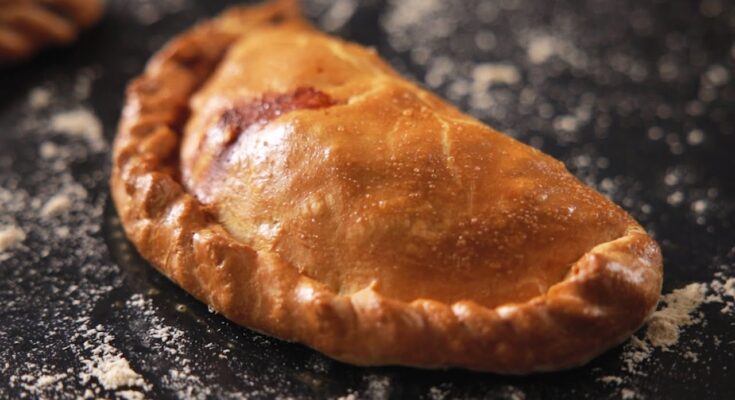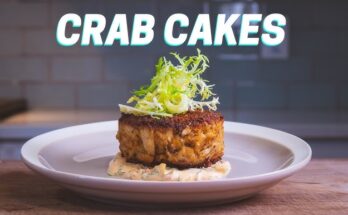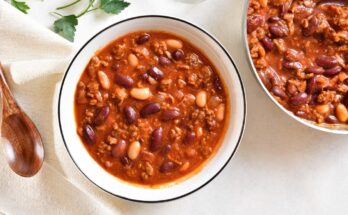Cornish Pasties Recipe: Cornish pasties are more than just food—they are a piece of British heritage wrapped in a golden crust. Originating from Cornwall, England, these hearty pastries were once the go-to meal for miners and laborers. The design of the pasty was ingenious: a thick crust on one side worked as a natural handle, allowing workers to eat their lunch without dirtying the rest of the pastry with coal-dusted hands. Over time, this practical food evolved into one of the most beloved traditional British dishes.
What sets Cornish pasties apart is their perfect balance of simple ingredients—flaky pastry, tender beef, root vegetables, and just the right seasoning. They are rustic yet comforting, filling yet wholesome, and can be enjoyed warm or cold. Whether you’re making them for a family meal, a picnic, or simply to taste a little bit of Cornish culture, this step-by-step guide will help you make authentic Cornish pasties at home.
What Makes Cornish Pasties Special
Unlike other pies or pastries, Cornish pasties carry a Protected Geographical Indication (PGI) status in the UK. That means only pasties made in Cornwall using specific traditional methods can be called “Cornish Pasties.” However, you can still recreate the authentic recipe in your kitchen using the same ingredients and steps.
What makes them unique is their half-moon shape and iconic crimp along the edge. The filling is raw when added to the pastry, allowing all the flavors to cook together inside while baking. This method results in tender beef, soft vegetables, and a rich, savory flavor that no pre-cooked filling can replicate.
The pasty isn’t just food—it’s a symbol of tradition, community, and comfort. Every bite tells a story of resilience, resourcefulness, and Cornish pride.
A Brief History of Cornish Pasties
The Cornish pasty dates back to the 13th century but became especially popular in the 18th and 19th centuries with Cornwall’s mining community. Miners’ wives would prepare these pasties before dawn, filling them with a hearty mixture of beef, potatoes, onion, and swede (rutabaga). The distinctive crimped edge acted as a handle that miners could hold with dirty hands, then discard.
In some cases, pasties even had two halves—savory on one side and sweet on the other—so miners had both a main course and dessert in one meal. This practicality, combined with the comforting flavors, made the Cornish pasty a staple for working families.
Today, Cornish pasties are enjoyed across the UK and around the world, celebrated as one of Britain’s most iconic comfort foods.
Ingredients You’ll Need
To make Cornish pasties at home, you need only a handful of simple, wholesome ingredients. These are not fancy or expensive, but when put together, they create a timeless dish that has stood the test of centuries.
Traditional Cornish Pasty Ingredients
- 500g (1 lb) beef skirt steak or chuck (cut into small cubes)
- 350g (12 oz) potatoes (peeled and diced into small cubes)
- 250g (9 oz) swede/rutabaga (peeled and diced into small cubes)
- 150g (5 oz) onion (finely chopped)
- 500g (4 cups) plain flour
- 250g (1 cup) cold butter or lard (cubed)
- 1 tsp salt
- 6 tbsp cold water (for pastry)
- 1 egg (beaten, for egg wash)
- Freshly ground black pepper
Optional Ingredients for Extra Flavor
- Fresh thyme or rosemary for an herby twist
- A pinch of nutmeg for depth of flavor
- A little grated cheese (if you like a richer taste)
- Carrot for extra sweetness (not traditional, but often used in modern versions)
Kitchen Tools and Equipment Checklist
- Large mixing bowl
- Rolling pin
- Sharp knife for chopping vegetables and meat
- Baking tray lined with parchment paper
- Pastry brush for egg wash
- Fork for crimping (if you don’t hand-crimp)
Step-by-Step Guide to Making Cornish Pasties
Now that you’ve got your ingredients ready, it’s time to dive into the actual process. Making Cornish pasties may look intimidating at first, but once you understand the steps, it becomes a fun and rewarding experience. Each stage is essential for creating the perfect balance of flaky pastry and savory filling.
Step 1 – Preparing the Pastry Dough
The pastry is the foundation of a Cornish pasty. It should be strong enough to hold the filling without breaking, yet tender and flaky when baked. The secret is using cold fat and minimal handling.
- In a large mixing bowl, add the plain flour and salt.
- Add the cold cubed butter or lard. Using your fingertips, rub the fat into the flour until it resembles breadcrumbs.
- Slowly add cold water, one tablespoon at a time, mixing until the dough just comes together. Do not overwork it, as this can make the pastry tough.
- Form the dough into a ball, wrap it in cling film, and chill in the fridge for at least 30 minutes.
Chilling is essential because it allows the gluten to relax and the fat to firm up, making the pastry easier to roll out later. A well-made pastry will bake into a golden, flaky crust that perfectly complements the hearty filling.
Step 2 – Chopping the Vegetables and Meat
The filling of a Cornish pasty is always made from raw ingredients. This way, everything cooks together inside the pastry, allowing the flavors to meld beautifully. Precision in chopping is crucial here—you want small, evenly sized cubes so everything cooks at the same rate.
- Peel and dice the potatoes into small cubes, around 1 cm (½ inch).
- Do the same with the swede (rutabaga). This adds a subtle sweetness and earthiness that balances the dish.
- Finely chop the onion. It should be small enough to melt into the filling while baking.
- Cut the beef skirt or chuck into small cubes. Skirt steak is traditional because it’s flavorful and tender when cooked slowly inside the pasty.
- Mix the beef and vegetables together in a large bowl. Season generously with salt and freshly ground black pepper.
The beauty of Cornish pasties lies in their simplicity—there’s no need for fancy sauces or marinades. The natural juices of the meat and vegetables combine while baking, creating a rich, savory filling that tastes like home. If you want to experiment, you can add fresh herbs or a pinch of spice, but the classic version is best left simple and rustic.
Step 3 – Assembling the Pasties
Now comes the fun part—putting everything together. This step transforms your dough and filling into the iconic half-moon shape of a Cornish pasty.
- Preheat your oven to 180°C (350°F).
- On a lightly floured surface, roll out the chilled pastry until about 5mm (¼ inch) thick.
- Using a plate or bowl as a guide, cut out circles of pastry around 20 cm (8 inches) in diameter.
- Place a generous spoonful of the filling mixture on one half of each circle, leaving space around the edges for sealing.
- Add a small pat of butter on top of the filling—this melts during baking and adds richness.
At this stage, it’s important not to overfill your pasty. Too much filling will cause the pastry to split while baking. The goal is to have enough filling for a hearty bite but still leave room for a proper seal. Think of it like packing a suitcase—you want it full but not bursting at the seams.
Step 4 – Sealing the Pasties with the Famous Crimp
The crimp isn’t just for looks—it’s a vital part of the pasty’s design. A good crimp keeps all the filling and juices locked inside while baking, ensuring a moist and flavorful result.
- Fold the pastry over the filling to form a half-moon shape.
- Press the edges together firmly with your fingers to seal.
- Starting at one end, twist and fold the edge over itself in a series of pinches, working your way along until you reach the other end. This is called “crimping.”
- If you struggle with hand-crimping, you can use a fork to press the edges, but the traditional hand-crimp is part of what makes a Cornish pasty authentic.
Crimping takes a little practice, but don’t worry if your first few attempts aren’t perfect—they’ll still taste delicious. Over time, you’ll develop your own crimping style. Some say that Cornish families could recognize each other’s pasties by their unique crimp.
Step 5 – Baking to Golden Perfection
The final stage is baking, where all your hard work comes together in a golden, mouthwatering pasty.
- Place the crimped pasties onto a baking tray lined with parchment paper.
- Brush the tops with beaten egg for a shiny, golden finish.
- Bake in the preheated oven for 45–55 minutes, or until the pastry is golden brown and cooked through.
- Let them cool slightly before serving, as the filling will be very hot.
When baked properly, the pastry should be crisp and flaky, while the filling is tender and bursting with flavor. The smell of baking pasties will fill your kitchen with a comforting aroma that’s hard to resist.
Once they’re ready, you can enjoy them hot from the oven, or let them cool and pack them for a picnic or lunchbox. Cornish pasties are just as good cold as they are warm, which is one of the reasons they’ve remained so popular for centuries.
Tips for the Perfect Cornish Pasties
Making Cornish pasties is an art, and like all traditional recipes, there are little tricks that can take your baking from good to great.
How to Get the Right Texture for Pastry
- Always use cold butter or lard. Warm fat will make the pastry greasy instead of flaky.
- Don’t over-handle the dough. The less you knead it, the lighter it will be.
- Rest the dough in the fridge before rolling to keep it firm.
Common Mistakes to Avoid
- Overfilling the pasty: This makes it hard to seal and can cause leaks.
- Cutting ingredients too large: They won’t cook evenly inside the pastry.
- Forgetting to season: The filling needs a generous amount of salt and pepper to bring out the flavors.
Storage and Reheating Tips
- Cornish pasties can be stored in the fridge for up to 3 days.
- To reheat, place them in the oven at 180°C (350°F) for 15–20 minutes. Avoid microwaving, as it makes the pastry soggy.
- They also freeze beautifully. Just wrap in foil or cling film and freeze for up to 3 months. Reheat from frozen in the oven for about 45 minutes.
Serving Ideas and Variations
One of the best things about Cornish pasties is their versatility. While the traditional recipe is unbeatable in terms of authenticity, there are countless ways to enjoy and adapt this iconic dish to suit different tastes, occasions, and diets.
Traditional Serving Suggestions
The classic way to serve a Cornish pasty is simple—straight from the oven, still warm, with nothing more than a cup of tea. In Cornwall, they’re often eaten as a stand-alone meal because they’re filling enough on their own. However, if you’re serving them at home for dinner, you might want to add a few sides:
- A crisp green salad for freshness
- Steamed vegetables like peas or carrots
- Gravy for dipping, though many purists insist a pasty needs no sauce
Cornish pasties also travel well, which is why they’ve always been popular for picnics, school lunches, and even road trips.
Modern Twists and Vegetarian Options
While beef skirt with root vegetables is traditional, modern variations are becoming more popular. Here are a few ideas to experiment with:
- Vegetarian Pasty: Replace the beef with mushrooms, lentils, or cheese and leek.
- Chicken Pasty: Use diced chicken breast with sweetcorn and herbs.
- Spiced Pasty: Add curry spices to the filling for a fusion-style pasty.
- Cheese & Onion Pasty: A rich and comforting alternative for those who prefer meat-free options.
These adaptations let you enjoy the pasty in new and exciting ways while still respecting the original concept.
What to Serve with Cornish Pasties
Cornish pasties can be enjoyed on their own, but if you’re serving them for dinner, here are some perfect pairings:
- Coleslaw: Adds a refreshing crunch.
- Pickles or Chutney: Complements the richness of the filling.
- Roast Potatoes: For those who love an extra dose of comfort food.
- Soup: A pasty with a hot bowl of soup makes a hearty winter meal.
Nutritional Information
Cornish pasties are hearty, filling meals, but like many comfort foods, they can be on the indulgent side. Let’s break it down so you know what you’re enjoying.
Calories and Nutritional Breakdown
On average, one traditional Cornish pasty (about 300g) contains:
- Calories: 700–800
- Protein: 25–30g
- Carbohydrates: 70–80g
- Fat: 35–40g
- Fiber: 5–6g
These numbers may vary depending on the size of your pasty and the exact ingredients used. While they’re not the lightest meal, they’re designed to be filling and sustaining—which made them ideal for miners and laborers in the past.
Healthier Alternatives for the Recipe
If you want to make a lighter version without sacrificing flavor, here are a few tweaks you can try:
- Lean Protein: Use chicken or turkey instead of beef.
- Lighter Pastry: Substitute half the butter with low-fat yogurt or use a wholemeal flour mix.
- Extra Veggies: Add spinach, kale, or mushrooms to increase the nutritional value.
- Smaller Portions: Make mini pasties instead of large ones—they’re easier to control in terms of calories and great for parties.
This way, you can enjoy the tradition of Cornish pasties while tailoring them to your lifestyle.
FAQs about Cornish Pasties Recipe
1. Can I freeze Cornish Pasties?
Yes! Wrap them individually in foil or cling film and freeze for up to 3 months. Reheat directly from frozen in the oven for about 45 minutes.
2. How long do Cornish Pasties last?
Freshly baked pasties last up to 3 days in the fridge. Store them in an airtight container to keep them fresh.
3. What’s the difference between a Cornish Pasty and a regular meat pie?
A Cornish pasty is folded into a half-moon shape and crimped along the edge, with raw ingredients sealed inside to cook together. A meat pie, by contrast, usually has pre-cooked filling and a different crust style.
4. Can I use store-bought pastry instead of homemade?
Yes, store-bought shortcrust pastry works fine if you’re short on time. However, homemade pastry gives a more authentic taste and texture.
5. Are Cornish Pasties served hot or cold?
They can be enjoyed both ways. Traditionally, miners ate them cold at lunchtime, but they are equally delicious warm from the oven.
Conclusion
Cornish pasties are more than just a meal—they’re a piece of history wrapped in golden pastry. From their humble beginnings as a practical lunch for Cornish miners to their present status as a beloved British classic, pasties have stood the test of time.
By following this step-by-step guide, you can recreate authentic Cornish pasties in your own kitchen. The flaky pastry, savory beef, tender vegetables, and rich flavors combine to create a dish that’s comforting, filling, and unforgettable. Whether you stick to the traditional recipe or experiment with modern twists, there’s no wrong way to enjoy a pasty.
So, roll up your sleeves, get baking, and bring a taste of Cornwall to your table—you won’t regret it.



